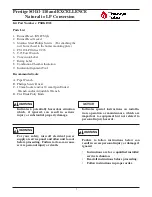
20 ENGLISH
WARNING:
Whenever performing a slide cut,
first pull the carriage full towards you and press
the handle all the way down, then push the car-
riage toward the guide fence. Never start the cut
with the carriage not pulled fully toward you.
If
you perform the slide cut without the carriage pulled
fully toward you unexpected kickback may occur and
serious personal injury may result.
WARNING:
Never attempt to perform a slide
cut by pulling the carriage towards you.
Pulling
the carriage towards you while cutting may cause
unexpected kickback resulting in possible serious
personal injury.
WARNING:
Never perform the slide cut with the
handle locked in the lowered position.
WARNING:
Never loosen the knob which
secures the carriage while the blade is rotating.
A
loose carriage while cutting may cause unexpected
kickback resulting in possible in serious personal
injury.
Miter cutting
Refer to the previously covered "Adjusting the miter
angle".
Bevel cut
►
Fig.41:
1.
Holder assembly
Loosen the lever and tilt the saw blade to set the bevel
angle (Refer to the previously covered "Adjusting the
bevel angle"). Be sure to retighten the lever firmly to
secure the selected bevel angle safely. Secure the
workpiece with a vise. Make sure the carriage is pulled
all the way back toward the operator. Switch on the
tool without the blade making any contact and wait
until the blade attains full speed. Then gently lower
the handle to the fully lowered position while applying
pressure in parallel with the blade and PUSH THE
CARRIAGE TOWARD THE GUIDE FENCE TO CUT
THE WORKPIECE. When the cut is completed, switch
off the tool and WAIT UNTIL THE BLADE HAS COME
TO A COMPLETE STOP before returning the blade to
its fully elevated position.
WARNING:
After setting the blade for a bevel
cut, before operating the tool ensure that the
carriage and blade will have free travel throughout
the entire range of the intended cut.
Interruption of
the carriage or blade travel during the cutting opera-
tion may result in kickback and serious personal injury.
WARNING:
While making a bevel cut keep
hands out of the path of the blade.
The angle of the
blade may confuse the operator as to the actual blade
path while cutting and contact with the blade will
result in serious personal injury.
WARNING:
The blade should not be raised
until it has come to a complete stop.
During a
bevel cut the piece cut off may come to rest against
the blade. If the blade is raised while it is rotating the
cut-off piece maybe ejected by the blade causing
the material to fragment which may result in serious
personal injury.
NOTICE:
When pressing down the handle, apply pres-
sure in parallel with the blade. If a force is applied per-
pendicularly to the turn base or if the pressure direction
is changed during a cut, the precision of the cut will be
impaired.
CAUTION:
(Only for European countries) always
set the sub-fence outside when performing left bevel
cuts.
Compound cutting
Compound cutting is the process in which a bevel
angle is made at the same time in which a miter angle
is being cut on a workpiece. Compound cutting can be
performed at the angle shown in the table.
Miter angle
Bevel angle
Left and Right 45°
Left 0° - 45°
Right 50°
Left 0° - 40°
Right 55°
Left 0° - 30°
Right 57°
Left 0° - 25°
When performing compound cutting, refer to "Press
cutting", "Slide cutting", "Miter cutting" and "Bevel cut"
explanations.
Cutting crown and cove moldings
Crown and cove moldings can be cut on a compound
miter saw with the moldings laid flat on the turn base.
►
Fig.42:
1.
52/38° type crown molding
2.
45° type
crown molding
3.
45° type cove molding
There are two common types of crown moldings and
one type of cove moldings; 52/38° wall angle crown
molding, 45° wall angle crown molding and 45° wall
angle cove molding. See illustrations.
►
Fig.43:
1.
Inside corner
2.
Outside corner
►
Fig.44:
1.
Inside corner
2.
Outside corner
There are crown and cove molding joints which are
made to fit "Inside" 90° corners ((1) and (2) in Fig.43 &
44) and "Outside" 90° corners ((3) and (4) in Fig.43 &
44).
Measuring
Measure the wall length and adjust workpiece on table
to cut wall contact edge to desired length. Always make
sure that cut workpiece length
at the back of the work-
piece
is the same as wall length. Adjust cut length for
angle of cut. Always use several pieces for test cuts to
check the saw angles.
When cutting crown and cove moldings, set the bevel
angle and miter angle as indicated in the table (A) and
position the moldings on the top surface of the saw
base as indicated in the table (B).
















































